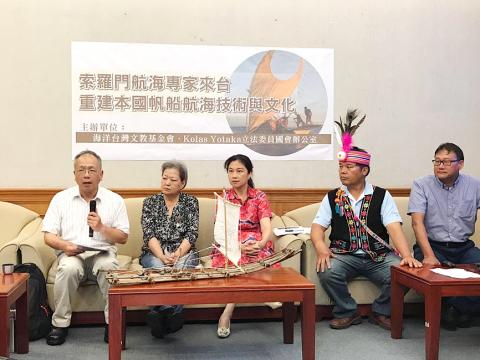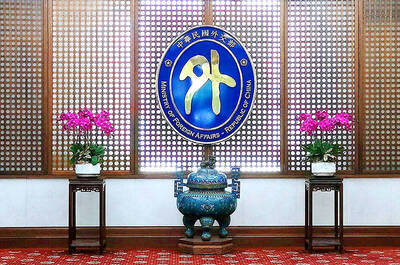Aborigines should revive the art of making sailboats to recover their connection with Austronesian people worldwide, Democratic Progressive Party Legislator Kolas Yotaka and Aboriginal culture advocates said yesterday.
At a news conference at the Legislative Yuan in Taipei, Kolas said when she visited Maori in New Zealand and told them she came from Taiwan, they often responded: “That is where our ancestors came from.”
“In our school textbooks we were always told to look to China, but we have never looked to the east and the Pacific Ocean,” she said.

Photo: Peng Wan-hsin, Taipei Times
Council For Farangaw Autonomy chairman Raranges Hoki Na Tungaw (羅福慶) said his organization has been trying to revive the Aboriginal art of making sailboats, what the Amis call fayan.
A fayan is a boat made of bamboo poles and a triangular or rectangular sail, he said.
His elders used to cross the “black tides” between Taiwan and Green Island (綠島) on this type of boat, he said.
Raranges said the council successfully reproduced a traditional sailboat in 2014 for the first time since the tradition died out and it now hopes the art can be handed down to the younger generation.
“Our culture has been withering, which makes us feel very insecure and anxious,” he said, adding that reproducing the sailboat would be one way to revive Aborigines’ adventurous spirit that connects them to the ocean.
Foundation of Ocean Taiwan chief executive officer Liu Chiung-hsi (劉炯錫) said his organization plans to visit Aboriginal elders in the east to collect more knowledge and stories about making boats.
The foundation would invite elders of the Taumako on the Solomon Islands to exchange their sailing knowledge with Taiwanese Aborigines next month or in September, he said, adding that the foundation also plans to sail its boats to Okinawa, Japan, next year.
“Sailing is the instinct of Austronesian Aborigines,” National Cheng Kung University Institute of Archeology director Liu Yi-chang (劉益昌) said.
“The ocean is not a barrier, but a pathway,” Liu said.

The Ministry of Foreign Affairs (MOFA) yesterday voiced dissatisfaction with the Comprehensive and Progressive Agreement for Trans- Pacific Partnership (CPTPP), whose latest meeting, concluded earlier the same day, appeared not to address the country’s application. In a statement, MOFA said the CPTPP commission had "once again failed to fairly process Taiwan’s application," attributing the inaction to the bloc’s "succumbing to political pressure," without elaborating. Taiwan submitted its CPTPP application under the name "Separate Customs Territory of Taiwan, Penghu, Kinmen and Matsu" on Sept. 22, 2021 -- less than a week after China

THE GOOD WORD: More than 100 colleges on both sides of the Pacific will work together to bring students to Taiwan so they can learn Mandarin where it is spoken A total of 102 universities from Taiwan and the US are collaborating in a push to promote Taiwan as the first-choice place to learn Mandarin, with seven Mandarin learning centers stood up in the US to train and support teachers, the Foundation for International Cooperation in Higher Education of Taiwan (FICHET) said. At the annual convention of the American Council on the Teaching of Foreign Languages held over the weekend in New Orleans, Louisiana, a Taiwan Pavilion was jointly run by 17 representative teams from the FICHET, the Overseas Community Affairs Council, the Steering Committee for the Test of Proficiency-Huayu, the

A home-style restaurant opened by a Taiwanese woman in Quezon City in Metro Manila has been featured in the first-ever Michelin Guide honoring exceptional restaurants in the Philippines. The restaurant, Fong Wei Wu (豐味屋), was one of 74 eateries to receive a “Michelin Selected” honor in the guide, while one restaurant received two Michelin stars, eight received one star and 25 were awarded a “Bib Gourmand.” The guide, which was limited to restaurants in Metro Manila and Cebu, was published on Oct. 30. In an interview, Feng Wei Wu’s owner and chef, Linda, said that as a restaurateur in her 60s, receiving an

Kaohsiung Mayor Chen Chi-mai (陳其邁) on Monday announced light shows and themed traffic lights to welcome fans of South Korean pop group Twice to the port city. The group is to play Kaohsiung on Saturday as part of its “This Is For” world tour. It would be the group’s first performance in Taiwan since its debut 10 years ago. The all-female group consists of five South Koreans, three Japanese and Tainan’s Chou Tzu-yu (周子瑜), the first Taiwan-born and raised member of a South Korean girl group. To promote the group’s arrival, the city has been holding a series of events, including a pop-up